
by bike, by train, by wind, by rain by Amber V. '24
getting around different cities
I’ve been thinking about different modes of transport through cities. In the past three years, I’ve visited over 10 cities and lived in three. Each of those three have their own method of transport: Copenhagen bikes, Tucson drives, and Boston, among other things, rides the metro.
I grew up in a place where only driving made any sense. Now that I’ve been exposed to other ways of getting around, I’m thinking about what I want to look for in future cities I live in.
biking
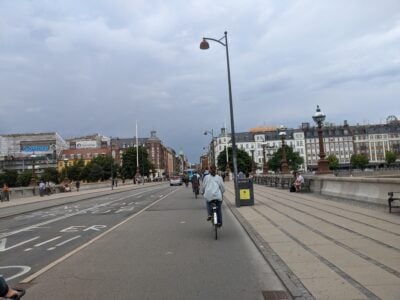
this is the bike lane! It is very wide.
In Copenhagen, Denmark, everybody bikes. A guide for a MISTI walking tour I went on explained that when cities were being re-built after WWII, they were designed with the new phenomenon of cars in mind. Copenhagen decided otherwise. Screw cars, they said. We’ll make this city as annoying for cars as possible. Instead we will ride bikes!
We do in fact ride bikes. I’ve heard from most people here that cars are made expensive via taxes, which can double the price of a car. I’m not sure how this translates to used cars — some are cheap enough that doubling the price wouldn’t make them inaccessible? All of the associated costs of having a car, such as maintenance, are also notably more expensive.
The bike infrastructure here is actually fantastic. The bike lanes are demarcated separately from roads and sidewalks, and are about 5 feet wide, so there’s space for two or even three bikes abreast. Most people bike single file, which allows faster cyclists to pass. Every major
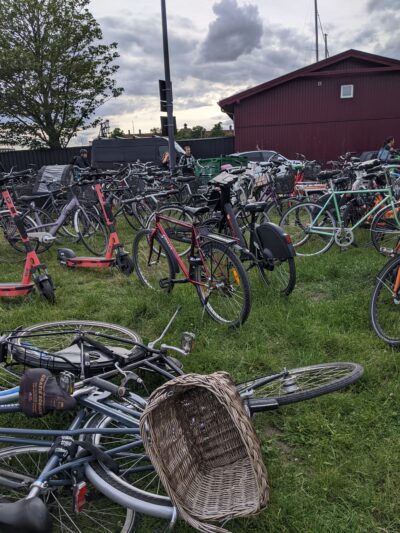
stoplight has a smaller set of lights for bikes. I’ve heard people who drive say that right turns are incredibly difficult, because you have to wait for a herd of bikes to fly past before you can even try; and then more bikes might come and cut you off.
Bikes are parked everywhere. People don’t lock them to objects here, they just lock the back tire to the frame. It’s a little riskier, because an opportunist bike thief could easily drive up in a big pick-up truck01 not that such things seem to exist in Copenhagen and load bikes by the dozen into the back, then cart them off to a shop and break the locks at their leisure. However, this doesn’t seem to happen often, and the freedom of being able to leave your bike literally anywhere and trust that it’ll still be there when you return is so lovely.
The pros of biking:
- exercise!
- I went to Copenhell, a metal fest, for four days, during which I didn’t really have time to go running. Usually when I spend four days without exercise, I get slightly irritable around day 3, even if I’m walking lots. Copenhell was located three miles from my apartment, however, so in addition to all the bouncing around and full-body head-banging I was doing at the festival, I was also biking lots! My body felt way better than it usually would in that circumstance.
- everything is max 30 minutes away by bike, which is nice
- I love seeing the city closer up, getting to know all the roads
- environmentalism!
- affordability
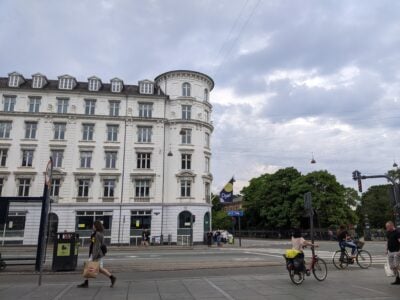
Copenhagen. Some more bikes in the wild
- my bike cost $200, maybe $250 if you factor in bike lights and the lock. There are cheaper options, which I would only pursue if I knew how to tell which of those options will break apart in two weeks.02 these prices surprised me at first — in Tucson you can find sturdy bikes for under $100. But the cost of living in Copenhagen is comparatively higher. There are also many, many more expensive options, most of which presumably have working hand brakes, which I can only envy.03 one of my hand brakes does work if you squeeze hard and aggressively! This is excellent for carpal tunnel.
cons:
- sometimes it is 2 am and windy and rainy and you are 20 minutes away from home.
- Sometimes it’s hot04 well… warm anyway, like 80 F, or 27 C, which is standard in Tucson for most of the year. But up here people melt and there’s no air conditioning in this city, so you arrive places sweaty and gross.
- sometimes you are tryna bring cake to work
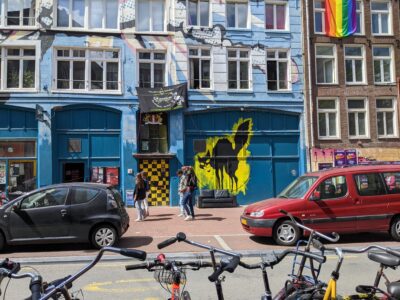
this isn’t even Copenhagen, it’s Amsterdam, but do you see what is looking at that cool cat mural? Some bikes
- sometimes you want to make a big shopping trip. You enjoy bringing all the groceries in from the car in one fell swoop, but not from the grocery store when it’s half a mile away. “Danish society is proper,” you think, as you hold a 16-pack of toilet paper under one arm and guide the bike handles with the other.
- apparently Copenhagen in winter is a city of darkness and cold. My friend who thinks 70 F is hot says that Denmark gets frozen and miserable for several months. For all of those months I would probably complain about every single bike trip I made.
- Biking isn’t accessible to everyone, though there are alternatives. The metro stations seem pretty accessible, and most of the city can be reached by metro, it just takes a bit longer. Bike lanes are open to wheelchair users as well.
All in all, I enjoy biking quite a lot! I wish more cities had good bike infrastructure, because I can’t imagine biking everywhere in Boston or Tucson.
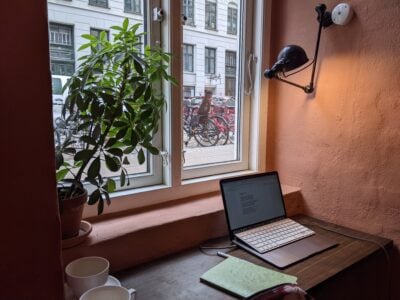
guess what is outside that window? Bikes
metro
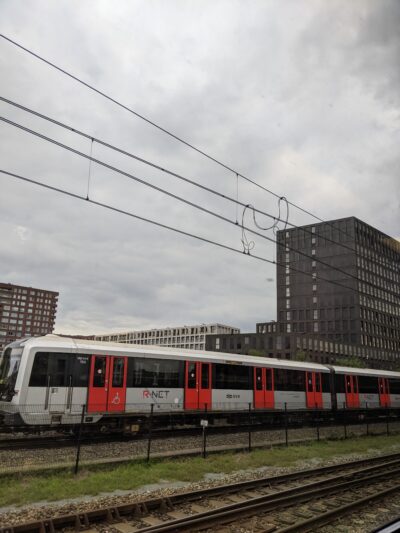
train in Berlin!
When I visited Tucson this winter, and spent two weeks getting everywhere by car, I felt the change. My body longed to move. I didn’t realize that walking to class would feel fundamentally different, but it did.
Subways similarly involve a lot of sitting. I don’t know how my body would react to using the subway long-term, as I’ve never lived in a city where subways are the main method of transport. I have, however, visited NYC, London, and Berlin, where the metro system works better than it does in Boston.
The metro: cheaper than a car, good for people-watching, and much cheaper than ubering home after a night out. I don’t love metro commutes, but I understand the environmental benefits of cities being connected by public transit. I can also see the draw of being able to chill out on the commute, rather than being alert and navigating traffic, as one would with a car or bike.
car
I was going to turn my notes for this section into actual prose, but I think the notes get my point across:
I love car; car go vroom. Car go vroom far away into mountain and down into valley. Car go vroom fast get places quick.
Car have space for cake for groceries for friends. In car can hear music go blast. Can sing. In car friend can read book while car go vroom down small winding highway.
Car have AC.05 actually the AC in my car dies when it gets too hot. I always pause to appreciate the irony when it’s 105 F and the stream of cool air behind my steering wheel putters out Car have battery for charge phone. Car have trunk for store bodies. Also camping supplies.
Car as American dream. Metaphor for freedom, eats gasoline.
And Then Boston
Boston is a sweet in-between in terms of transportation. Many students cannot afford parking spots, let alone actual vehicles. But that’s okay, you don’t really need one — there’s a metro which only catches fire occasionally, and usually drops you within 20 minutes’ walking distance of wherever you want to go. You can also bike! The cars are vicious and speedy, however, and bike lanes generally don’t exist, so bike at your own risk. Also, half the year there’s ice.
Most of the interesting things that happen during college happen on campus, anyway.
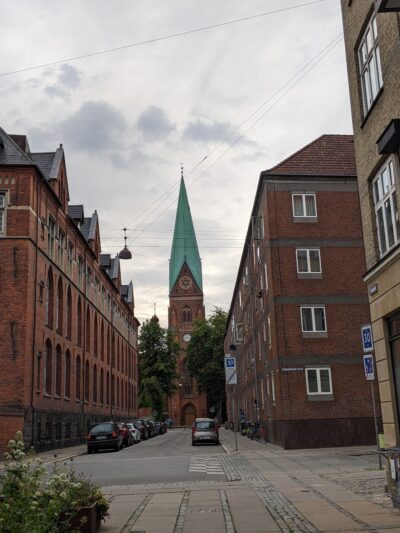
Ultimately I’m glad I was introduced to biking full-time to get around. I know that driving everywhere isn’t the most environmental option, and the costs of insurance and maintenance add up. In many cities, it seems that owning a car is more trouble than it’s worth. I still plan to own a car later in life, if doing so is practical, but for day-to-day commutes, I’m having a good time with bikes. I like that biking gives you a smaller version of the freedom cars afford you — and, hey, extra exercise!
Despite the above complaints about scary fast cars on Boston streets, I’m looking forward to biking around more when I get back to campus.